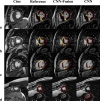Improved Quantification of Myocardium Scar in Late Gadolinium Enhancement Images: Deep Learning Based Image Fusion Approach
- PMID: 33599043
- PMCID: PMC8359184
- DOI: 10.1002/jmri.27555
Improved Quantification of Myocardium Scar in Late Gadolinium Enhancement Images: Deep Learning Based Image Fusion Approach
Abstract
Background: Quantification of myocardium scarring in late gadolinium enhanced (LGE) cardiac magnetic resonance imaging can be challenging due to low scar-to-background contrast and low image quality. To resolve ambiguous LGE regions, experienced readers often use conventional cine sequences to accurately identify the myocardium borders.
Purpose: To develop a deep learning model for combining LGE and cine images to improve the robustness and accuracy of LGE scar quantification.
Study type: Retrospective.
Population: A total of 191 hypertrophic cardiomyopathy patients: 1) 162 patients from two sites randomly split into training (50%; 81 patients), validation (25%, 40 patients), and testing (25%; 41 patients); and 2) an external testing dataset (29 patients) from a third site.
Field strength/sequence: 1.5T, inversion-recovery segmented gradient-echo LGE and balanced steady-state free-precession cine sequences ASSESSMENT: Two convolutional neural networks (CNN) were trained for myocardium and scar segmentation, one with and one without LGE-Cine fusion. For CNN with fusion, the input was two aligned LGE and cine images at matched cardiac phase and anatomical location. For CNN without fusion, only LGE images were used as input. Manual segmentation of the datasets was used as reference standard.
Statistical tests: Manual and CNN-based quantifications of LGE scar burden and of myocardial volume were assessed using Pearson linear correlation coefficients (r) and Bland-Altman analysis.
Results: Both CNN models showed strong agreement with manual quantification of LGE scar burden and myocardium volume. CNN with LGE-Cine fusion was more robust than CNN without LGE-Cine fusion, allowing for successful segmentation of significantly more slices (603 [95%] vs. 562 (89%) of 635 slices; P < 0.001). Also, CNN with LGE-Cine fusion showed better agreement with manual quantification of LGE scar burden than CNN without LGE-Cine fusion (%ScarLGE-cine = 0.82 × %Scarmanual , r = 0.84 vs. %ScarLGE = 0.47 × %Scarmanual , r = 0.81) and myocardium volume (VolumeLGE-cine = 1.03 × Volumemanual , r = 0.96 vs. VolumeLGE = 0.91 × Volumemanual , r = 0.91).
Data conclusion: CNN based LGE-Cine fusion can improve the robustness and accuracy of automated scar quantification.
Level of evidence: 3 TECHNICAL EFFICACY: 1.
Keywords: Deep learning; image fusion; image segmentation; late gadolinium enhancement; myocardial scar; scar quantification.
© 2021 The Authors. Journal of Magnetic Resonance Imaging published by Wiley Periodicals LLC. on behalf of International Society for Magnetic Resonance in Medicine.
Figures




Similar articles
-
Three-dimensional Deep Convolutional Neural Networks for Automated Myocardial Scar Quantification in Hypertrophic Cardiomyopathy: A Multicenter Multivendor Study.Radiology. 2020 Jan;294(1):52-60. doi: 10.1148/radiol.2019190737. Epub 2019 Nov 12. Radiology. 2020. PMID: 31714190 Free PMC article.
-
Artificial Intelligence for Contrast-Free MRI: Scar Assessment in Myocardial Infarction Using Deep Learning-Based Virtual Native Enhancement.Circulation. 2022 Nov 15;146(20):1492-1503. doi: 10.1161/CIRCULATIONAHA.122.060137. Epub 2022 Sep 20. Circulation. 2022. PMID: 36124774 Free PMC article.
-
Evaluation of fully automated myocardial segmentation techniques in native and contrast-enhanced T1-mapping cardiovascular magnetic resonance images using fully convolutional neural networks.Med Phys. 2021 Jan;48(1):215-226. doi: 10.1002/mp.14574. Epub 2020 Dec 1. Med Phys. 2021. PMID: 33131085
-
Recent Advances in Fibrosis and Scar Segmentation From Cardiac MRI: A State-of-the-Art Review and Future Perspectives.Front Physiol. 2021 Aug 3;12:709230. doi: 10.3389/fphys.2021.709230. eCollection 2021. Front Physiol. 2021. PMID: 34413789 Free PMC article. Review.
-
Artifacts at Cardiac MRI: Imaging Appearances and Solutions.Radiographics. 2025 Jan;45(1):e230200. doi: 10.1148/rg.230200. Radiographics. 2025. PMID: 39745866 Review.
Cited by
-
Revival and Revision of Right Ventricular Assessment by Machine Learning.JACC Cardiovasc Imaging. 2022 May;15(5):780-782. doi: 10.1016/j.jcmg.2022.01.019. JACC Cardiovasc Imaging. 2022. PMID: 35512950 Free PMC article. No abstract available.
-
Lightweight preprocessing and template matching facilitate streamlined ischemic myocardial scar classification.J Med Imaging (Bellingham). 2024 Mar;11(2):024503. doi: 10.1117/1.JMI.11.2.024503. Epub 2024 Mar 21. J Med Imaging (Bellingham). 2024. PMID: 38525295 Free PMC article.
-
Validation of a deep learning-based software for automated analysis of T2 mapping in cardiac magnetic resonance imaging.Quant Imaging Med Surg. 2023 Oct 1;13(10):6750-6760. doi: 10.21037/qims-23-375. Epub 2023 Aug 17. Quant Imaging Med Surg. 2023. PMID: 37869306 Free PMC article.
-
Progress in the Clinical Application of Artificial Intelligence for Left Ventricle Analysis in Cardiac Magnetic Resonance.Rev Cardiovasc Med. 2024 Dec 19;25(12):447. doi: 10.31083/j.rcm2512447. eCollection 2024 Dec. Rev Cardiovasc Med. 2024. PMID: 39742214 Free PMC article. Review.
-
Investigating methods to enhance interpretability and performance in cardiac MRI for myocardial scarring diagnosis using convolutional neural network classification and One Match.PLoS One. 2025 Jun 9;20(6):e0313971. doi: 10.1371/journal.pone.0313971. eCollection 2025. PLoS One. 2025. PMID: 40489519 Free PMC article.
References
-
- Di Marco A, Anguera I, Schmitt M, et al. Late gadolinium enhancement and the risk for ventricular arrhythmias or sudden death in dilated cardiomyopathy. JACC Heart Fail 2017;5(1):28‐38. - PubMed
-
- Disertori M, Rigoni M, Pace N, et al. Myocardial fibrosis assessment by LGE is a powerful predictor of ventricular tachyarrhythmias in ischemic and nonischemic LV dysfunction: A meta‐analysis. JACC Cardiovasc Imaging 2016;9(9):1046‐1055. - PubMed
-
- Chan RH, Maron BJ, Olivotto I, et al. Prognostic value of quantitative contrast‐enhanced cardiovascular magnetic resonance for the evaluation of sudden death risk in patients with hypertrophic cardiomyopathy. Circulation 2014;130(6):484‐495. - PubMed
Publication types
MeSH terms
Substances
Grants and funding
LinkOut - more resources
Full Text Sources
Other Literature Sources
Research Materials

